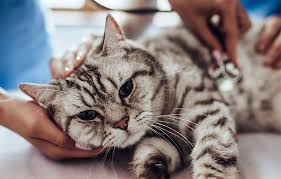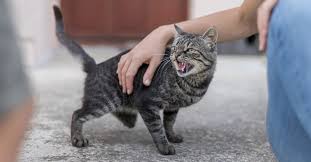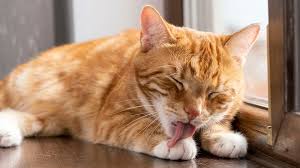Common behaviors of cats can range from endearing and entertaining to sometimes baffling. As beloved pets, cats have unique instincts, habits, and personality traits that make them intriguing companions. Understanding these behaviors can help cat owners provide better care and form closer bonds with their feline friends. While many of a cat’s actions are instinctual, reflecting their evolution as solitary hunters and territorial animals, others are learned or influenced by their environment.
Some of these common behaviors include grooming, scratching, hunting, kneading, purring, and marking territory. Observing these actions can reveal a lot about a cat’s emotional and physical needs, as well as how they communicate with both humans and other animals.
Cats spend a significant amount of their day grooming themselves. This is not just about cleanliness; it’s also a way for them to regulate body temperature, distribute natural oils, and reduce stress. Grooming can also be a social activity, as cats often groom each other to strengthen bonds. When cats groom themselves excessively, however, it can sometimes signal anxiety or skin problems that may require attention.
Scratching is another common cat behavior that serves several purposes. Cats scratch to mark their territory, as the glands in their paws release pheromones that convey ownership. Scratching also helps cats keep their claws sharp and healthy by removing the outer nail sheath. Providing scratching posts can help satisfy this natural urge and prevent cats from damaging furniture.
Even well-fed domestic cats have a strong hunting instinct. This behavior stems from their wild ancestors, who needed to hunt to survive. Cats will often pounce on toys, small objects, or even moving feet, mimicking the actions they would take in the wild. They might bring their “prey” (like a toy or even a captured insect) to their owners as a form of social bonding, sharing their “catch” as a gesture of trust.
Kneading is when cats press their paws alternately into soft surfaces, such as blankets or their owner’s lap. This behavior originates from kittenhood, when kittens knead their mother’s belly to stimulate milk flow. In adult cats, kneading is often a sign of contentment and relaxation, but it can also mark territory, as scent glands in their paws release pheromones during the process.
Purring is a well-known behavior associated with cats being content, but it can also indicate other emotions, such as fear or discomfort. A cat’s purr has a calming effect and can even promote healing by lowering stress levels. Cats may purr to soothe themselves or to communicate with their owners, especially if they want attention, are hungry, or are in pain.
Cats are naturally territorial animals, and they often mark their territory through scent marking. Besides scratching, cats may rub their heads and bodies against objects or people to leave their scent. This is their way of claiming ownership and creating a familiar scent landscape in their environment. Additionally, some cats may spray urine to mark territory, which is a common behavior among unneutered males
Understanding these common behaviors can greatly improve the relationship between cats and their owners. By recognizing these natural actions and learning what they mean, owners can respond to their cat’s needs more effectively, making for a happier and more harmonious living environment.
Body Language of Cats

Cats primarily use body language to convey their emotions.
1. Tail Position: A cat with a high, upright tail is often feeling confident and friendly; a puffed-up tail indicates fear or aggression.
2. Ears: Forward-facing ears show interest or curiosity; flattened ears suggest fear, aggression, or irritation.
3. Eyes: Slow blinking can indicate trust and relaxation; dilated pupils can be a sign of excitement, fear, or arousal.
4. Posture: A relaxed, sprawled-out posture shows contentment; an arched back with fur standing up suggests the cat feels threatened.
5. Purring: While generally a sign of contentment, purring can sometimes indicate distress; observe other body cues to understand the context.
Vocalizations: What Your Cat is Saying
Cats use a variety of vocalizations to communicate with humans and other animals.
1. Meowing: Cats meow to communicate with people; short, repetitive meows often mean they want attention, while louder meows can indicate hunger or discomfort.
2. Purring: Most cats purr when they’re content, but they may also purr when they’re frightened or in pain as a self-soothing mechanism.
3. Hissing: Hissing is a clear sign of fear or aggression; it’s a warning to back off and give the cat space.
4. Chirping: Cats may chirp when they see birds or other prey animals; this sound indicates excitement and hunting instincts.
5. Yowling: This loud, drawn-out sound may occur when a cat is in heat, feels lonely, or is signaling territoriality to other cats.
Read Also: 7 Medicinal Health Benefits of Tongkat Ali (Eurycoma Longifolia)
Play Behavior in Cats

Play is essential for a cat’s mental and physical well-being.
1. Pouncing: Cats pounce on toys, people, or other animals to practice their hunting skills; it’s instinctual and reflects natural hunting behavior.
2. Stalking: When a cat stalks a toy or another pet, they are practicing predatory behavior; this is an important outlet for their natural instincts.
3. Biting: Gentle nipping during play is normal, but if biting becomes too aggressive, redirect your cat’s energy to a toy.
4. Scratching: Cats scratch objects to mark territory, relieve stress, and maintain claw health; provide scratching posts to satisfy this need.
5. Chasing: Cats may chase toys, other cats, or even people’s hands; it’s a sign of playful energy and should be encouraged with safe toys.
Grooming Habits and Their Importance
Cats are known for their meticulous grooming routines.
1. Self-Cleaning: Cats groom themselves to keep their fur clean, remove parasites, and regulate body temperature; this behavior also helps them stay scent-free, which is essential for hunting.
2. Stress Relief: Grooming can help a cat feel calm and comfortable; excessive grooming, however, can indicate stress or anxiety.
3. Social Bonding: Cats often groom each other as a form of bonding; if your cat grooms you, it’s a sign of affection and trust.
4. Skin and Coat Health: Regular grooming distributes natural oils across the skin and fur, keeping it healthy and shiny; it also prevents matting, especially in long-haired breeds.
Territoriality: Why Cats Mark Their Space
Cats are naturally territorial creatures and use various methods to mark their space.
1. Scent Marking: Cats have scent glands on their cheeks and paws; when they rub against objects or scratch surfaces, they’re leaving their scent to mark territory.
2. Spraying: Unneutered cats, particularly males, may spray urine to signal ownership; neutering and behavior training can help reduce this behavior.
3. Scratching: Cats scratch to mark their space visually and leave scent marks from glands in their paws; providing scratching posts can help prevent damage to furniture.
4. Body Rubbing: Cats rub their bodies against people, objects, or other animals to transfer their scent; this behavior marks them as part of their safe territory.
Read Also: The Origin and Development of Soil (Soil Genesis)
Hunting Instincts and Behavior

Despite being domesticated, cats retain strong hunting instincts.
1. Stalking and Pouncing: Cats naturally stalk and pounce on toys, insects, and other small animals as part of their hunting behavior; interactive toys are great for providing a healthy outlet.
2. Chasing and Catching: Cats may chase moving objects or animals, such as birds and insects; this behavior is part of their predatory drive and helps them stay active.
3. Gift Bringing: Some cats bring “gifts” (like small animals) to their owners; this is thought to be a form of sharing or teaching, especially if the cat views you as part of its family.
4. Play Hunting: Play behavior in kittens and adult cats often mimics hunting actions, like biting and scratching; providing appropriate toys can help them safely satisfy these instincts.
Sleeping Patterns and Preferences
Cats have unique sleep habits that reflect their survival instincts.
1. Catnaps: Cats sleep in short bursts throughout the day and night, often staying semi-alert; this napping pattern allows them to conserve energy while staying aware of potential threats.
2. Cozy Spaces: Cats seek warm, enclosed spaces for sleeping, which makes them feel secure; providing cozy beds or blankets can make your cat feel safe.
3. Long Sleep Periods: Cats can sleep anywhere from 12 to 16 hours a day, with kittens and older cats often sleeping even longer; this rest is essential for their growth, development, and overall health.
4. Nocturnal Tendencies: While domesticated cats are more adaptable, they often remain crepuscular (most active at dawn and dusk); you may notice increased activity during these times.
Socialization with Humans and Other Animals
Socialization is essential for a well-adjusted cat, helping them feel comfortable and confident.
1. Building Trust: Cats may initially be wary of new people or animals; providing a safe space and allowing them to approach at their own pace helps build trust.
2. Introducing New Animals: When introducing a new pet, keep them separated initially; gradual introductions with supervision can help prevent stress or aggression.
3. Positive Reinforcement: Reward your cat for calm behavior around people or other animals; treats, praise, and gentle petting encourage positive social experiences.
4. Social Play: Engaging in interactive play with your cat and other pets helps foster bonding and reduces the chances of conflict, especially in multi-pet households.
Signs of Stress or Discomfort in Cats
Cats may exhibit various signs when they’re stressed or uncomfortable. Recognizing these signs can help you address issues early.
1. Hiding or Avoidance: Cats that are stressed may hide more than usual; this behavior indicates a need for security and avoidance of perceived threats.
2. Excessive Grooming: Over-grooming, especially to the point of hair loss, can signal stress or anxiety; providing a calm environment and consistent routine can help.
3. Changes in Appetite: A stressed cat may eat less or more than usual; if changes persist, consult a veterinarian to rule out underlying health issues.
4. Aggression or Withdrawal: Sudden aggression or withdrawal from social interactions can indicate discomfort; try to identify any recent changes in the environment that could be causing stress.
Litter Box Behavior and Preferences
A cat’s litter box habits reveal a lot about its comfort and preferences.
1. Location Matters: Cats prefer litter boxes in quiet, private areas; if they’re avoiding the litter box, consider its location and ensure it’s not in a high-traffic area.
2. Cleanliness: Cats are very clean animals and appreciate a clean litter box; scooping daily and fully cleaning the box weekly encourages consistent use.
3. Litter Type: Some cats are particular about litter texture; experiment with different types if your cat seems uncomfortable or hesitant to use the box.
4. Litter Box Size and Quantity: A large litter box allows for easy movement, and households with multiple cats should provide multiple boxes to reduce stress and prevent territorial disputes.
Aging and Behavioral Changes in Cats
As cats age, they may experience changes in behavior and require adjustments in care.
1. Decreased Activity: Older cats may slow down and prefer rest over play; providing comfortable, accessible resting spots is essential for their well-being.
2. Increased Vocalization: Some senior cats become more vocal due to confusion or discomfort; if this behavior arises, consult a vet to assess potential health issues.
3. Altered Sleeping Patterns: Aging cats may sleep more or less than usual; keeping a consistent routine can help them feel secure and comfortable.
4. Changes in Litter Box Habits: Older cats may experience mobility issues, making it difficult to access the litter box; consider providing a low-sided box to make it easier for them.
Do you have any questions, suggestions, or contributions? If so, please feel free to use the comment box below to share your thoughts. We also encourage you to kindly share this information with others who might benefit from it. Since we can’t reach everyone at once, we truly appreciate your help in spreading the word. Thank you so much for your support and for sharing!
Read Also: Importance of Sports Technology

